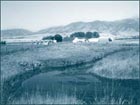
Spring creeks are known as excellent trout streams. Continually refreshed from under ground, their water never freezes and they can nurture large trout. But twenty years ago, the Thompson and Benhart creeks weren’t known for spectacular fishing—few people were aware of them at all. The Milesnicks, busy with raising cattle, allowed fishers to come on the stream at will. “Access was given to everybody,” says Mary Kay Milesnick. “They had to stop and ask, but we let everyone on.”
As more fishers discovered the creeks, monitoring access became burdensome. “Things became noticeable in 1990,” recalls Tom Milesnick. “By ’95 there was a really big influx. That was when fly-fishing became the ‘in’ thing to do.” (A River Runs through It, the Robert Redford-directed movie that celebrated fly-fishing, was released in 1992.) The Milesnicks had attempted to restore some control over their property with a sign-in program in 1991. “That was when we went to written permission, with the drop box and sheets by the garage,” says Mary Kay Milesnick.
As the numbers of fishers rose, so did the abuse of the resource. According to Tom, some guests were fishing the creeks “as many as five or six times a week.” Others guided fly-fishing trips without notifying or compensating the Milesnicks in any way. The increasing activity created a managerial headache and took time away from the cattle business. Milesnick family members were spending up to three hours a day talking to fishers.
Around the same time, Tom Milesnick recognized that the creeks had slowly been deteriorating from years of overgrazing on adjacent ranches. The streambeds were laden with silt, which choked off most of the aquatic vegetation that fosters a healthy insect population, necessary for a good trout stream. Tom described the scene as “bleak.” He recalls: “The banks were beaten down and both streams were real wide and shallow, and Thompson was filled with silt. I knew they needed help.”
Because reclamation was costly, Tom purchased a backhoe and did it himself. Beginning in 1993, Tom spent six years slowly rejuvenating the two streams. Digging holes, laying rocks, removing sediment, planting streamside and aquatic vegetation, and channeling water into areas so fish could spawn, Tom singlehandedly brought the creeks back to life. In addition, he lined several sections of the stream entirely with rocks and gravel to provide his cattle with a path across the stream. “The cows come from literally miles to cross at these places,” says Tom. “They really seem to like them.” Contributing to the overall health of the streams was a grazing practice that had been in place since 1992. Cattle have to be away from the stream banks for extended periods of time, allowing vegetation to take hold.
As the winter of 1998 set in, Tom and Mary Kay set out in search of a way to limit the general public’s use of their land without cutting it off completely. “Nonuse is as bad as overuse,” says Tom.
Because the creeks fall almost entirely within the bounds of their ranch, restricting public access was only a matter of posting their property. But how should they allocate access? The two spoke first with state officials about by-permit-only fishing. “They wanted to have people go to a regional office in Bozeman to get permits, and hours from 8 a.m to 5 p.m. during the week don’t work for the fishing public,” says Tom. “Plus I lose my direct control over my land, and then I can’t ranch when I need to.”
Then they looked to the private sector. The reclamation work had cost around $70,000. Perhaps a pay fishery could help recoup these costs. They learned more about pay fisheries at several private spring creeks in nearby Paradise Valley, and Dave Kumlien, a friend and local small business owner, advised them on establishing one. “The Milesnicks were interested in income, but were very concerned about protecting the fishery and the experience,” says Kumlien. The two agreed to limit the number of fishers to six a day, and to charge a rod fee of $50 per fisher (now $75 during the busiest season). With the system in place, Tom could ensure that the creeks would not be overfished and that there would be money for future restorations and upkeep.
He started the pay fishery in 1999. “Now there is an understanding and respect for my land that wasn’t there before,” Tom said. “I don’t know why—I guess it is just human nature.”
The numbers alone tell a compelling story. The spring creeks host 500 to 600 fishers a year, compared to more than 1,550 in 1998. What was once perhaps a mere one-mile stretch of fishable water on the creeks has become between four and five miles of prime trout habitat. What was once a strain on the Milesnicks’ time and assets has blossomed into a business that grosses around $30,000 a year, nearly 40 percent of the ranch’s net profits.
The creeks themselves have undergone a miraculous transformation. Stretches of water once void of all but silt and rock are rich with trout, insects, and vegetation. The previously barren banks now flourish with clusters of cattails and rows of long grass and overhanging bushes. Through the enforcement of property rights and the access to a growing private market, a classic tragedy of the commons has been overcome.
Kris Kumlien, a student at Montana State University, was a research intern at PERC during 2001. He spent the past semester in Washington, D.C., working as an aide to Senator Conrad Burns of Montana.


